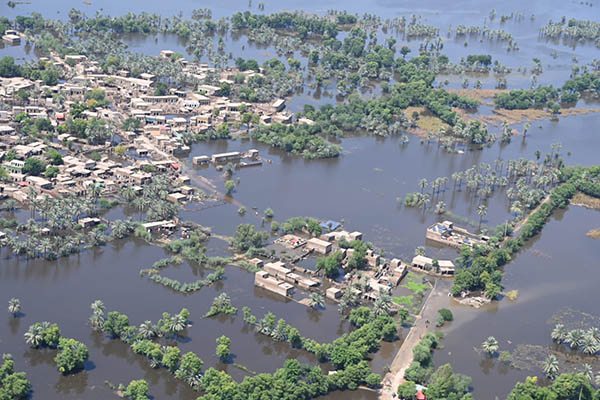
An aerial view of a flood-hit district of Sindh. Twitter
In its 2022 Floods Response Plan for Pakistan, the World Health Organization (WHO) has said the government needs $48 million for the food security and agriculture sector to provide food/cash assistance and protect livestock and produce essential commodities.
On Tuesday, the United Nations and the Government of Pakistan issued a flash appeal for $160 million to help the country tackle the devastating floods that have killed nearly 1,200 people and destroyed homes, roads and crops, impacting 33 million people nationwide. Detailing plans for utilizing these funds, WHO said the bulk–$48 million—had been allocated for food security, with an aim to complement the government’s efforts to ensure access to food and expedite the restoration of livelihoods.
“Urgent food security and livelihoods needs will be addressed by targeting the most vulnerable flood-affected population, such as those relying on casual/daily wage labor, persons with disabilities, female- and child-headed households, refugees as well as subsistence-level farmers, and livestock holders,” it said of the “priority response.” This would include, it said, providing conditional and unconditional food/cash assistance; vaccinating livestock; providing animal feed; and crop inputs for the upcoming plantation season.
Of the $48 million requirement, $30.08 million is needed for food/cash assistance and $17.91 million to protect livestock and produce vital food.
According to WHO, $31 million is needed for shelter, noting 6.4 million are “in need,” while 5.2 million would be targeted for relief in the urgent phase. These funds, it said, would ensure the provision of emergency shelter; basic non-food items such as bedding and blankets; and tool-kits and cash-for-work to remove debris and repair damaged homes. It stressed that some 1.5 million people were estimated to require shelter support, and around 130,000 households—over 900,000 people—would be targeted with different types of assistance based on needs.
The third sector to be targeted is water, sanitation and hygiene, which has been allocated $25 million, targeting 2.2 million of the 3.8 million people in need. It said this would support, based on priority and relevance, improved access to sufficient water of “appropriate quality and quantity” for drinking, cooking and maintaining personal hygiene; water treatment and water quality monitoring and surveillance; restoration of damaged water systems; improved access to toilets and washing facilities; and improved access to critical information to promote safe hygiene practices.
In addition, the WHO has earmarked $22.8 million for the health sector, which has 3.2 million people in need and 1.2 million targeted for relief. It warned that major health concerns were diarrheal disease, malaria, dengue fever, skin infection and respiratory tract infection. The ongoing floods might also exacerbate a cholera outbreak, it said, warning more casualties and infrastructural damage were anticipated, as much of the affected population remained exposed to standing water and minimal access to basic health services.
The remaining sectors being targeted for relief and rehabilitation are protection (13.2 million); education ($10.2 million); nutrition ($9 million); and logistics ($1.1 million).
Ongoing impact
According to the National Disaster Management Authority (NDMA)’s latest report, 1,191 people have died in various rain-related incidents across Pakistan since mid-June, including 422 in Sindh; 264 Khyber-Pakhtunkhwa; 253 Balochistan; 188 Punjab; 41 Pakistan-administered Kashmir; 22 Gilgit-Baltistan; and 1 in Islamabad.
In the past 24 hours, it said, 21,001 homes were partially damaged—17,981 in KP; 3,018 Sindh; 2 Pakistan-administered Kashmir—while 48,437 were completely destroyed—45,310 in Sindh; 21,105 KP; 3 Pakistan-administered Kashmir. It said 1,335 livestock had also perished in the past 24 hours, with 1,078 in Sindh; 239 KP; 18 Pakistan-administered Kashmir.
According to the WHO, 116 of Pakistan’s 154 districts (75%) have been impacted by the floods, with Sindh the worst-hit, followed by Balochistan. It has reiterated that over 33 million people have been affected and more than 6.4 million are in dire need of humanitarian aid, including 421,000 refugees.
